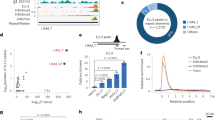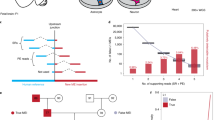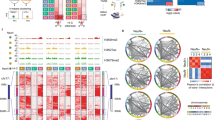Abstract
Long interspersed element 1 (LINE-1 or L1) retrotransposons have markedly affected the human genome. L1s must retrotranspose in the germ line or during early development to ensure their evolutionary success, yet the extent to which this process affects somatic cells is poorly understood. We previously demonstrated that engineered human L1s can retrotranspose in adult rat hippocampus progenitor cells in vitro and in the mouse brain in vivo1. Here we demonstrate that neural progenitor cells isolated from human fetal brain and derived from human embryonic stem cells support the retrotransposition of engineered human L1s in vitro. Furthermore, we developed a quantitative multiplex polymerase chain reaction that detected an increase in the copy number of endogenous L1s in the hippocampus, and in several regions of adult human brains, when compared to the copy number of endogenous L1s in heart or liver genomic DNAs from the same donor. These data suggest that de novo L1 retrotransposition events may occur in the human brain and, in principle, have the potential to contribute to individual somatic mosaicism.
This is a preview of subscription content, access via your institution
Access options
Subscribe to this journal
Receive 51 print issues and online access
$199.00 per year
only $3.90 per issue
Buy this article
- Purchase on Springer Link
- Instant access to full article PDF
Prices may be subject to local taxes which are calculated during checkout




Similar content being viewed by others
Change history
27 August 2009
The position of the 'DAPI' label on Fig. 1f was altered on 27 August 2009.
References
Muotri, A. R. et al. Somatic mosaicism in neuronal precursor cells mediated by L1 retrotransposition. Nature 435, 903–910 (2005)
Tang, Y., Nyengaard, J. R., De Groot, D. M. & Gundersen, H. J. Total regional and global number of synapses in the human brain neocortex. Synapse 41, 258–273 (2001)
Uchida, N. et al. Direct isolation of human central nervous system stem cells. Proc. Natl Acad. Sci. USA 97, 14720–14725 (2000)
Brouha, B. et al. Hot L1s account for the bulk of retrotransposition in the human population. Proc. Natl Acad. Sci. USA 100, 5280–5285 (2003)
Moran, J. V. et al. High frequency retrotransposition in cultured mammalian cells. Cell 87, 917–927 (1996)
Ostertag, E. M. et al. A mouse model of human L1 retrotransposition. Nature Genet. 32, 655–660 (2002)
Ostertag, E. M., Prak, E. T., DeBerardinis, R. J., Moran, J. V. & Kazazian, H. H. Determination of L1 retrotransposition kinetics in cultured cells. Nucleic Acids Res. 28, 1418–1423 (2000)
Kulpa, D. A. & Moran, J. V. Ribonucleoprotein particle formation is necessary but not sufficient for LINE-1 retrotransposition. Hum. Mol. Genet. 14, 3237–3248 (2005)
Moran, J. & Gilbert, N. Mammalian LINE-1 Retrotransposons and Related Elements (ASM Press, 2002)
Myers, J. S. et al. A comprehensive analysis of recently integrated human Ta L1 elements. Am. J. Hum. Genet. 71, 312–326 (2002)
Morrish, T. A. et al. DNA repair mediated by endonuclease-independent LINE-1 retrotransposition. Nature Genet. 31, 159–165 (2002)
Gilbert, N., Lutz, S., Morrish, T. A. & Moran, J. V. Multiple fates of L1 retrotransposition intermediates in cultured human cells. Mol. Cell. Biol. 25, 7780–7795 (2005)
Symer, D. E. et al. Human L1 retrotransposition is associated with genetic instability in vivo . Cell 110, 327–338 (2002)
Yeo, G. W. et al. Alternative splicing events identified in human embryonic stem cells and neural progenitors. PLoS Comput. Biol. 3, e196 (2007)
Bourc'his, D. & Bestor, T. H. Meiotic catastrophe and retrotransposon reactivation in male germ cells lacking Dnmt3L. Nature 431, 96–99 (2004)
Takai, D. & Jones, P. A. The CpG island searcher: a new WWW resource. In Silico Biol. 3, 235–240 (2003)
Yu, F., Zingler, N., Schumann, G. & Stratling, W. H. Methyl-CpG-binding protein 2 represses LINE-1 expression and retrotransposition but not Alu transcription. Nucleic Acids Res. 29, 4493–4501 (2001)
Tchenio, T., Casella, J. F. & Heidmann, T. Members of the SRY family regulate the human LINE retrotransposons. Nucleic Acids Res. 28, 411–415 (2000)
Lee, C., Wevrick, R., Fisher, R. B., Ferguson-Smith, M. A. & Lin, C. C. Human centromeric DNAs. Hum. Genet. 100, 291–304 (1997)
Pavlicek, A., Paces, J., Zika, R. & Hejnar, J. Length distribution of long interspersed nucleotide elements (LINEs) and processed pseudogenes of human endogenous retroviruses: implications for retrotransposition and pseudogene detection. Gene 300, 189–194 (2002)
Grimaldi, G., Skowronski, J. & Singer, M. F. Defining the beginning and end of KpnI family segments. EMBO J. 3, 1753–1759 (1984)
Gage, F. H. Mammalian neural stem cells. Science 287, 1433–1438 (2000)
Prak, E. T., Dodson, A. W., Farkash, E. A. & Kazazian, H. H. Tracking an embryonic L1 retrotransposition event. Proc. Natl Acad. Sci. USA 100, 1832–1837 (2003)
Garcia-Perez, J. L. et al. LINE-1 retrotransposition in human embryonic stem cells. Hum. Mol. Genet. 16, 1569–1577 (2007)
van den Hurk, J. A. et al. L1 retrotransposition can occur early in human embryonic development. Hum. Mol. Genet. 16, 1587–1592 (2007)
Thomson, J. A. et al. Embryonic stem cell lines derived from human blastocysts. Science 282, 1145–1147 (1998)
Zhang, S. C., Wernig, M., Duncan, I. D., Brustle, O. & Thomson, J. A. In vitro differentiation of transplantable neural precursors from human embryonic stem cells. Nature Biotechnol. 19, 1129–1133 (2001)
Forslund, O. et al. Nucleotide sequence and phylogenetic classification of candidate human papilloma virus type 92. Virology 312, 255–260 (2003)
Acknowledgements
We thank J. Simon for excellent schematic drawings, M. L. Gage, J. Kim and H. Kopera for editorial comments, B. Miller and R. Keithley for cell culture assistance, C. T. Carson for hESC advice, D. Chambers and J. Barrie for flow cytometry assistance, L. Randolph-Moore for molecular advice, B. Aimone for statistics advice, T. Liang for microarray assistance, and Y. Lineu and J. Mosher for helpful comments. We also thank T. Fanning and M. Klymkowsky for the ORF1 protein and SOX3 antibodies, respectively. F.H.G. and N.G.C. are supported by the Picower Foundation, G. Harold and Leila Y. Mathers Charitable Foundation, Lookout Fund (MH082070), and the California Institute for Regenerative Medicine (CIRM). J.L.G.-P. is supported by Plan Estabilizacion Grupos SNS ENCYT 2015 (EMER07/56, Instituto de Salud Carlos III, Spain) and through the IRG-FP7-PEOPLE-2007 Marie Curie program. K.S.O. was supported by grants GM069985 and NS048187 from the National Institutes of Health (NIH). J.V.M. was supported by grants GM082970 and GM069985 from the NIH and by the Howard Hughes Medical Institute. Work in the laboratories of K.S.O. and J.V.M. only used NIH-approved stem cell lines.
Author Contributions N.G.C. and F.H.G. directed the project. J.V.M. and J.L.G.-P. directed aspects of the project conducted at Michigan. N.G.C., J.L.G.-P., J.V.M. and F.H.G. designed experiments and drafted the manuscript. N.G.C., F.H.G., J.L.G-P. and G.E.P. performed the experiments. G.W.Y. and M.T.L. carried out bioinformatics data analysis. Y.M. performed electrophysiology experiments. M.M. and K.S.O. provided hESC culture and NPC differentiation assistance. All authors commented on or contributed to the current manuscript.
Author information
Authors and Affiliations
Corresponding author
Supplementary information
Supplementary Information
This file contains Supplementary Methods, Supplementary References, Supplementary Figures S1-S11 with Legends and Supplementary Tables S1-S5. (PDF 10345 kb)
Rights and permissions
About this article
Cite this article
Coufal, N., Garcia-Perez, J., Peng, G. et al. L1 retrotransposition in human neural progenitor cells. Nature 460, 1127–1131 (2009). https://doi.org/10.1038/nature08248
Received:
Accepted:
Published:
Issue Date:
DOI: https://doi.org/10.1038/nature08248
This article is cited by
-
Single-cell lineage tracing with endogenous markers
Biophysical Reviews (2024)
-
Exploratory analysis of L1 retrotransposons expression in autism
Molecular Autism (2023)
-
Proceedings of the inaugural Dark Genome Symposium: November 2022
Mobile DNA (2023)
-
Transposable elements as essential elements in the control of gene expression
Mobile DNA (2023)
-
Widespread somatic L1 retrotransposition in normal colorectal epithelium
Nature (2023)
Comments
By submitting a comment you agree to abide by our Terms and Community Guidelines. If you find something abusive or that does not comply with our terms or guidelines please flag it as inappropriate.



